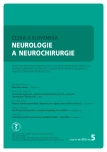The 3F Test Dysarthric Profile – Normative Speach Values in Czech
Authors:
M. Košťálová 1,2; M. Mračková 2,3; R. Mareček 2,3; D. Beránková 2; I. Eliášová 3; E. Janoušová 4; J. Roubíčková 5; J. Bednařík 1,2; I. Rektorová 2,3
Authors‘ workplace:
Neurologická klinika LF MU a FN Brno
1; Výzkumná skupina Aplikované neurovědy, CEITEC – Středoevropský technologický institut, MU, Brno
2; I. neurologická klinika LF MU a FN u sv. Anny v Brně
3; Institut biostatistiky a analýz MU, Brno
4; Klinická logopedie, Praha
5
Published in:
Cesk Slov Neurol N 2013; 76/109(5): 614-618
Category:
Short Communication
Poděkování za konzultace Mgr. Haně Růžičkové, Ph.D., z I. NK LF a VFN v Praze. Práce vznikla s podporou grantového projektu IGA MZČR NT/13499 Řeč, její poruchy, kognitivní funkce u Parkinsonovy nemoci, projektu OP VAVpI CEITEC, Středoevropský technologický institut (CZ.1.05/1.1.00/02.0068) a s podporou MZ ČR – RVO (FNBr, 65269705).
Overview
Dysarthria could be a hallmark of a serious brain disorder. The 3F test enables clinicians to characterize a wide range of signs and symptoms of dysarthria. It could also be a starting point for a structured therapy using a therapeutic material developed in connection with the diagnostic test. The authors aimed to provide an overview of possible uses of the diagnostic tool “The 3F Test – Dysarthric Profile” and provide preliminary normative data. The 3F test consists of three subtests: I. Faciokinesis, II. Phonorespiration, III. Phonetics. The overall Index of Dysarthria (ID) is a sum of 45 items with the maximum score of 90. Approximate normative values were established in a group of 52 healthy volunteers, 26 women and 26 men, with the mean age of 63.7 (median 63.5) years, without cognitive deficit and without signs and symptoms of neurological disease. All subjects underwent neurological, speech and language examination, Mini-Mental-State Examination to exclude cognitive deficit, and 3F test. Data collection took place between June 2010 and June 2012. The final ID score showed significantly lower values in men compared to women (p = 0.039), and insignificant trend towards decline in higher age (r = –0,226; p >0.05). Normative values for the ID score and its subscores were set at the level of the 5th percentile (with respect to non-Gaussian distribution of the ID score and subscores): the established normal values were ≥25 points for faciokinesis and phonorespiration in women and ≥24 and ≥27 points in men, respectively; for phonetics, normal values were set at ≥28 points in women and ≥26 in men; the normal values for the ID score were suggested at the level of ≥80 points for women and ≥79 points for men. The 3F test scores and subscores depended on gender. Newly established normal values allow the currently used threshold between slight dysarthria and a normal finding to be refined. They could serve as a starting point for further standardization of the 3F Test and its use in both clinical practice and research.
Key words:
dysarthria – diagnosis – normative data
The authors declare they have no potential conflicts of interest concerning drugs, products, or services used in the study.
The Editorial Board declares that the manuscript met the ICMJE “uniform requirements” for biomedical papers.
Sources
1. Košťálová M. Afázie a možnosti jejího skríninkového stanovení pomocí Mississippi Aphasia Screening Test – české verze (MASTcz). Neurol Prax 2012; 13(6): 314 – 316.
2. Love RJ, Webb WG. Mozek a řeč. Neurologie nejen pro logopedy. 1st ed. Praha: Portál 2009.
3. Cséfalvay ZS, Marková J. Dyzartria. In: Kerekrétiová A(ed). Základy logopédie. Bratislava: Univerzita Komenského Bratislava 2009.
4. Duffy RJ. Motor speech disorders: Substrates, Differential Diagnosis and Management. 2nd ed. St. Louis: Mosby ‑ Year Book 2005.
5. Košťálová M, Bednařík J, Mechl M et al. Multimediální atlas poruch řeči a příbuzných kognitivních funkcí. Brno: Masarykova universita 2006 [on-line]. Available from URL: http:/ / portal.med.muni.cz/ clanek ‑ 312 - multimedialni ‑ vyukovy ‑ atlas ‑ poruch ‑ reci ‑ a ‑ pribuznych ‑ kognitivnich ‑ funkci.html.
6. Neubauer K. Neurogenní poruchy komunikace u dospělých: diagnostika a terapie. 1st ed. Praha: Portál 2007.
7. Roubíčková J, Hedánek J, Stráník A. Dysartrický profil Test 3F. 3rd ed. Praha: Galén 2011.
8. Cséfalvay ZS, Košťálová M. Neurogénne poruchy komunikácie u dospelých. Neurol Prax 2012; 13(6): 304 – 307.
9. Hedánek J, Roubíčková J. Dysartrický profil – Test 3F. Praha: DeskTop Publishing Filozofické fakulty, Univerzity Karlovy 1997.
10. Válová K, Košťálová M, Lasotová N, Roubíčková J, Klenková J. Terapeutický materiál – dysartrie [on-line]. Available from URL: http:/ / www.fnbrno.cz/ nemocnice ‑ bohunice/ neurologicka ‑ klinika/ dysartrie/ t4497.
11. Folstein MF, Fostein SE, McHugh PR. Mini‑mental state: a practical method for grading the cognitive state of patients for the clinician. J Psychiatr Res 1975; 12(3): 189 – 198.
12. Mekyska J, Smékal Z, Košťálová M, Mračková M, Skutilová S, Rektorová I. Motorické aspekty poruch řeči u Parkinsonovy nemoci a jejich hodnocení. Cesk Slov Neurol N 2011; 74/ 107(6): 662 – 668.
13. Cséfalvay ZS, Mekyska J, Košťálová M. Dysartrie. In: Cséfalvay ZS, Lechta V (eds). Diagnostika narušené komunikační schopnosti u dospělých. Praha: Portál 2013.
14. Eliasova I, Mekyska J, Kostalova M, Marecek R,Smekal Z, Rektorova I. Acoustic evaluation of short‑term effects of repetitive transcranial magnetic stimulation on motor aspects of speech in Parkinson’s disease. J Neural Transm 2013; 120(4): 597 – 605.
15. Dršata J et al. Foniatrie – Hlas. 1st ed. Havlíčkův Brod: Tobiáš 2011.
Labels
Paediatric neurology Neurosurgery NeurologyArticle was published in
Czech and Slovak Neurology and Neurosurgery

2013 Issue 5
Most read in this issue
- Wilson Disease
- Glioblastoma Multiforme – a Review of Pathogenesis, Biomarkers and Therapeutic Perspectives
- Tumefactive Variant of Multiple Sclerosis – Two Case Reports
- The 3F Test Dysarthric Profile – Normative Speach Values in Czech
